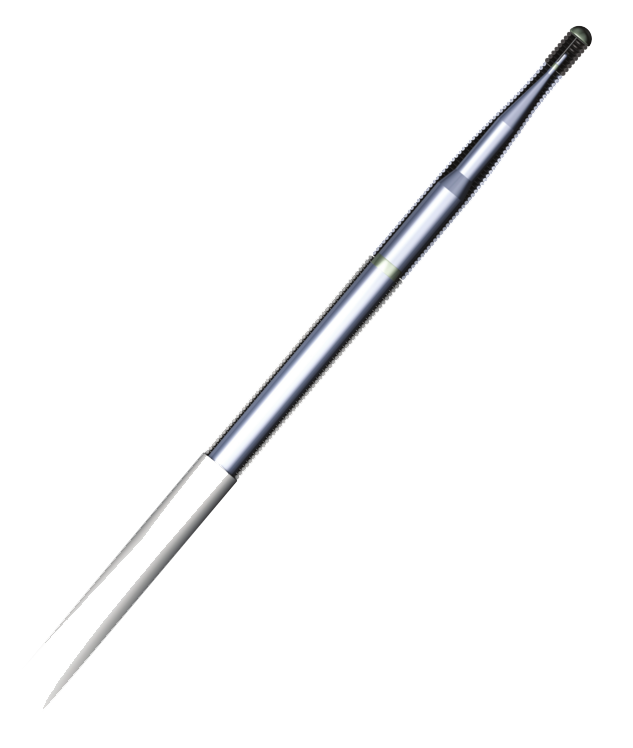The TAD™ II Tapered Guide Wire System (0.035" - 0.018") with supportive body and soft tip with shaping ribbon for tight lesions and vessels sensitive to spasm.

Experience precise steerability when traversing tight stenoses and negotiating vessels sensitive to spasm, along with added support and enhanced trackability for versatile access to acute angles and challenging vessels.
Support And Crossability
Features include:
- Atraumatic guide wire tip with shaping ribbon
- Maximum distal support designed for a range of anatomies and traversing acute angles
- Hydrophobic coating that provides excellent lubricity and low friction1
Precise Steerability with Shapeable Tip
- The TAD™ II Tapered Guide Wire, featuring a 0.035” proximal shaft support and a 0.018” tip, ensures precise steerability for navigating tight stenoses and vessels prone to spasm.
- This wire provides added support and enhanced trackability for versatile access to acute angles and challenging vessels.
Ordering Information
| Product | Part Number | Diameter | Length | Tip Style | Units Per Package |
|---|---|---|---|---|---|
| TADTM II | 1012069-07 | 0.035 in | 260 cm | Shaping Ribbon | 5 |
| TADTM II LOC | 1012069-05 | 0.035 in | 145 cm | Shaping Ribbon | 5 |
| LOCTM Guide Wire Extension | 1012068-10 | 0.035 in | 115 cm | N/A | 5 |
Data on file at Abbott.
References
- Tóth et al. How to select a guidewire: technical features and key characteristics. Heart 2015;101:645-652
MAT-2006306 v3.0
Hi-Torque™ Steerable
Guide Wire

INDICATIONS
The Hi-Torque™ Steerable Guide Wire is intended for use in angiographic procedures to introduce and position diagnostic and interventional devices within the peripheral vasculature during percutaneous procedures. The wire can be torqued to facilitate navigation through tortuous vessels.
The Hi-Torque™ Steerable Guide Wire is not intended for use in the coronary or neurovasculature.
CONTRAINDICATIONS
The Hi-Torque™ Steerable Guide Wire is not intended for use in the coronary or neurovasculature.
WARNINGS
This device is designed and intended for ONE-TIME USE ONLY. DO NOT RESTERILIZE AND / OR REUSE.
Observe all guide wire movement in the vessels. Before a guide wire is moved or torqued, the tip movement should be examined under fluoroscopy. Do not torque a guide wire without observing corresponding movement of the tip; otherwise, vessel trauma may occur.
Torquing a guide wire against resistance may cause guide wire damage and / or guide wire tip separation. Always advance or withdraw the guide wire slowly. Never push, auger, withdraw, or torque a guide wire which meets resistance. Resistance may be felt and / or observed under fluoroscopy by noting any buckling of the guide wire tip. Determine the cause of resistance under fluoroscopy and take any necessary remedial action.
If the wire tip becomes entrapped within the vasculature, DO NOT TORQUE THE GUIDE WIRE.
Maintain continuous flush while removing and reinserting the guide wire to prevent air from entering the catheter system. Perform all exchanges slowly to prevent air entry and / or trauma. Wipe the wire before all exchanges.
When reintroducing the guide wire, confirm that the interventional device tip is free within the vessel lumen and not against the vessel wall. Failure to do so may result in vessel trauma upon guide wire exit from the device. Use the radiopaque marker of the interventional device to confirm position.
PRECAUTIONS
Guide wires are delicate instruments and should be handled carefully. Prior to use and when possible during the procedure, inspect the guide wire carefully for bends, kinks, or other damage. Do not use damaged wires. Using a damaged wire may result in vessel damage and / or inaccurate torque response.
Confirm the compatibility of the guide wire diameter with the interventional device before actual use.
Free movement of the guide wire within the interventional device is an important feature of a steerable guide wire system because it gives the user valuable tactile information. Test the system for any resistance prior to use. Adjust or replace the hemostatic valve with an adjustable valve if it is found to inhibit guide wire movement.
ADVERSE EVENTS
Potential Adverse Events associated with use of this device may include the following but not limited to perforation, dissection, occlusion, myocardial infarction, embolism and infection.
MAT-2306607 v1.0
